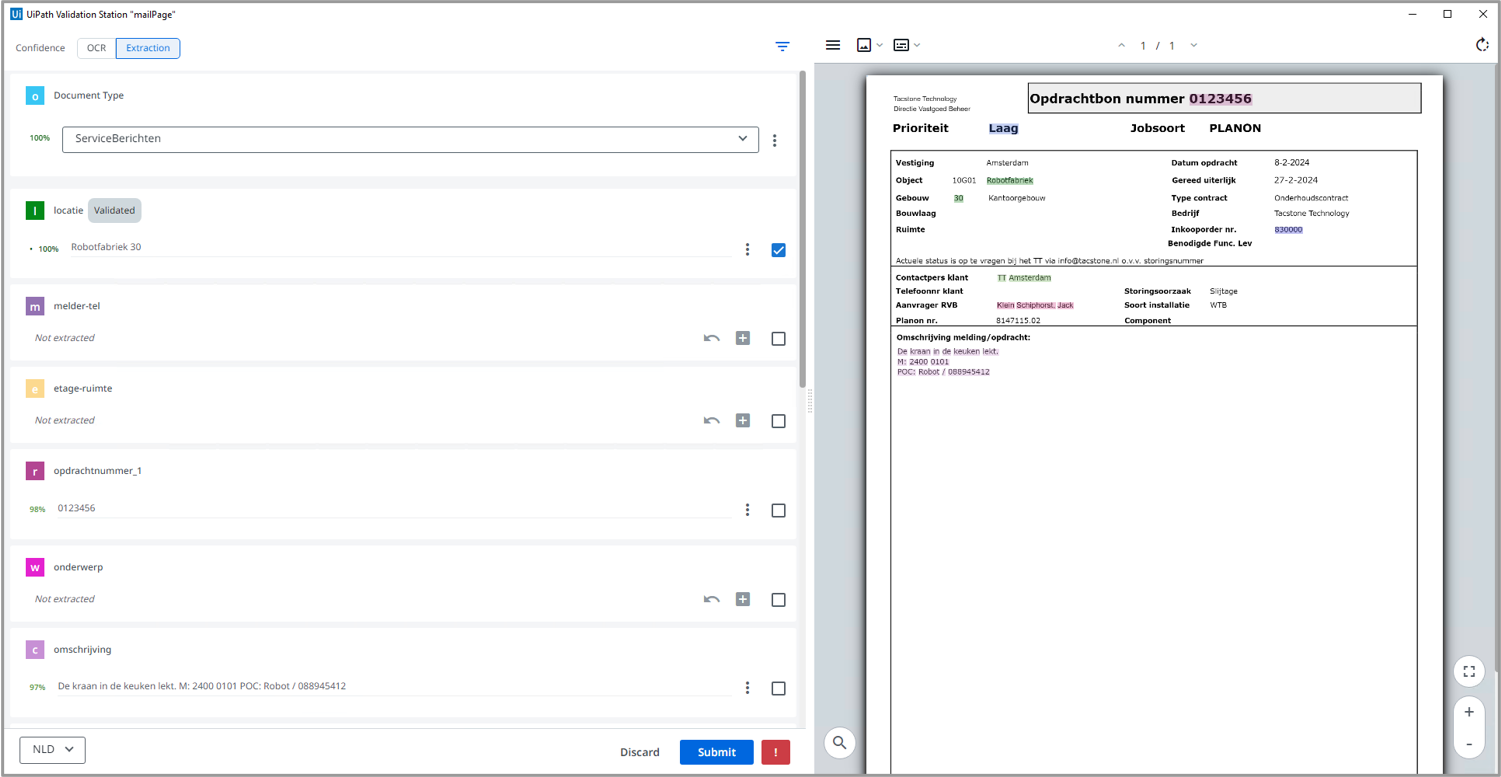SPIE enhances efficiency through the combination of RPA and AI

Working smarter with RPA

Facilitating growth in a tight labor market

120.000+ requests per year
At SPIE Netherlands, software robots installed by Tacstone are streamlining operations across two different departments. In the Finance department, Robotic Process Automation (RPA) enables the team to achieve more with the same number of employees. Meanwhile, at the Servicedesk, RPA combined with AI is accelerating the handling of 270,000 service requests each year.
SPIE is an international service provider involved in building management and maintenance, assisting clients with their energy transition and digital transformation. The company operates in forty countries with a total workforce of 48,000 employees. The Building Solutions division of SPIE Netherlands also applies smart automation within its own operations.
“Technology plays a crucial role in our core processes,” says divisional controller Jan Heinen. “Firstly, in our digitalisation agenda. Buildings generate a lot of data, and we want to be able to interpret this data, among other things, to achieve predictive maintenance. This allows us to predict potential failures based on system data.”

Working smarter with RPA
Additionally, internal processes are being digitalized. “These are the core processes necessary to keep the business running, such as finance operations. It’s becoming increasingly difficult to find people, so if we want to grow, we need to do more with the same number of employees. This means working smarter, and for that, we use RPA among other tools.”
He was already familiar with the benefits of RPA. The question he posed to the Finance team was, “What are the tasks you find frustrating and that could be done more efficiently?”

“We didn’t focus on where the greatest savings could be achieved, as the goal is to inspire people with the possibilities of digitalisation and to support growth in a tight labour market.”
Jan Heinen | Division controller at SPIE
Time Savings Through Robotics
The software robot was developed in collaboration with Tacstone Technology, which was already working on a software robot for the Servicedesk at the time. “I knew they delivered high-quality work. They collaborated with us to set up the process and develop a script. We currently have four core processes running on RPA. We use just one robot, which can be scheduled 24/7 with processes. For now, everything fits within this single software robot, which can be deployed flexibly.”
One example of such a process is project reviews. “For these reviews, standard forms are prepared that run on SAP. The process involves opening Excel, starting a macro, and saving it, which takes about ten minutes, and then moving it to a folder. This used to take people a few hours per week. Now, a software robot handles it.”
270.000 requests per year
However, the most advanced software robot operates not in finance, but at the Servicedesk of SPIE Building Solutions. Here, RPA is combined with AI. “We are responsible for processing all customer inquiries to SPIE, 24/7,” says Pieter Quanjel, Servicedesk Manager. “That amounts to 270,000 requests per year, spread across various channels such as building management systems that generate automatic notifications, traditional telephony, and emails.”
Team leader Ilse Dankers adds: “We work with a team of around thirty students who handle these requests. Students are deployed based on the volume of tickets, with the peak number of requests being significantly higher during the day than at night. Our staff do not have a technical background, so they work with the information displayed in our application. This is where the strength of a software robot lies: it can assist in creating requests as accurately as possible.”

Figure 1: SPIE utilizes UiPath Document Understanding to automate the processing of semi-structured service reports.
Software robot retrieves information and assesses urgency
Initially, RPA was implemented to process a portion of the large volume of incoming emails—120,000 per year—more efficiently. Quanjel explains, “Many of these emails are standardised. This led us to explore what we could do with them. We wanted to extract basic information and automatically determine the urgency of incoming emails so that those with lower urgency could be addressed later. This need led us on a search that eventually brought us to RPA.”
“We clearly outlined our functional requirements: which applications we use and what information we want to extract from customer emails and tickets. From a selection of suppliers, Tacstone was chosen as the provider. This was a carefully considered decision after evaluating various options on the market.”
Implementing AI
In the first phase, SPIE and Tacstone programmed the software robot to extract information from emails. However, this process turned out to be time-consuming and complex.

“We wanted more control over the process, so we began exploring additional possibilities within our software environment using AI, specifically in the form of intelligent document understanding.”
Pieter Quanjel| Manager Servicedesk at SPIE
A significant change was the shift from operating in the front end of the application, where the software robot performed literal click actions, to interacting through the backend via data links. This not only improved the speed but also enhanced the stability of the process.

Figure 2: SPIE uses a Machine Learning model (AI) to enhance the intelligence of the robots.
Simple for users
Dankers: “Technically, this is quite complex on the backend, but for us as users, it is very straightforward and intuitive. One can quickly learn how it works. This is a significant advantage of this solution. We no longer need Tacstone’s assistance at every step; we can manage and adjust it ourselves.”
For employees, the change in their work is minimal. Dankers explains: “They simply see that a ticket has been picked up by the software robot. It makes their work easier because many fields are already filled in, so they don’t have to do everything themselves. They only need to verify that the information is correct. They continue to check the information and determine the urgency, after which they can quickly forward the request. This results in less time spent searching for information and handling administrative tasks.”

Figure 3: SPIE employees can train the robot themselves, enabling it to handle new document types and service report layouts.

“The goal is not to replace people, but to make their work more efficient.”
Ilse Dankers | Team leader at SPIE
Time saved
Quanjel: “With the new solution, we can also easily add a new client and train the system. By continuously adding more client information, the system becomes smarter and should eventually be able to independently extract the necessary information from emails and perform actions.”
The time savings are substantial: “Processing a regular ticket or email used to take between three and four minutes. With the robotic solution, this has been reduced to just 20-30 seconds to check the ticket and possibly add some information. This represents a significant time saving. Moreover, this solution also improves quality.”
Smooth collaboration
The team at SPIE is very satisfied with the collaboration with Tacstone. Quanjel: “We worked with dedicated programmers who provided excellent advice and were genuinely involved. They are always available, and any questions receive an immediate response. They think along and are eager to move forward, sometimes even faster than we do.”

